Meet the participants

All participants will present at the university's 3MT® heats on Wednesday, March 19, 2025. The top six will advance to the finals to be held on Thursday, March 20, 2025. The heats and finals will be held on campus in-person and will also be livestreamed.
Faculty of Engineering and Applied Science
-
Ruvini Edirisooriya Mohottige
Program
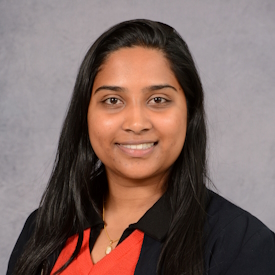
Mechanical Engineering (MASc)
Supervisor
Dr. Sheldon Williamson
3MT® PRESENTATION
Reconfigurable Multi-port Solid State Transformer for DC Fast Charging Stations
This study presents a Solid-State Transformer (SST)-based Electric Vehicle (EV) fast charging station that enhances reliability and optimizes power distribution. Traditional SST-based stations rely on a shared DC bus, susceptible to faults that disrupt the entire system. The proposed system introduces multiple independent DC buses, isolating faults and improving reliability while eliminating the need for additional DC-DC converters, reducing costs and space. Reconfigurable ports deliver 800V, 400V, and 200V, accommodating heavy, medium, and light EVs. A dynamic reconfiguration algorithm adjusts the ports based on vehicle requirements. MATLAB/Simulink simulations confirm stable charging currents and voltages under varying loads. A scaled-down prototype achieves an efficiency of 93.75%. The system enhances EV fast charging stations' reliability, scalability, and cost-effectiveness.
About Ruvini
Fueled by a passion for power electronics and transportation electrification, I am driven by the vision of a carbon-free future. My research is not just about circuits and converters, it’s about shaping a world where sustainability and technology go hand in hand. Beyond the lab, I am an explorer at heart. Traveling allows me to embrace new cultures, connect with diverse minds, and witness the beauty of our planet firsthand. Growing up in a serene village in Sri Lanka, I’ve always admired nature’s beauty which is an inspiration that continues to shape my journey in both research and life.
-
Akash Samanta
Program
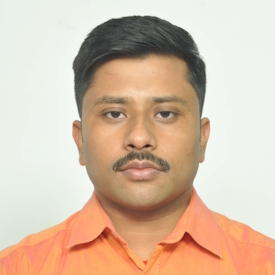
Electrical and Computer Engineering (PhD)
Supervisor
Dr. Sheldon Williamson
3MT® PRESENTATION
BRAIN: Battery Reliability and AI-driven Innovation for Next-gen EVs
Electric vehicles (EVs) are shaping the future of transportation, but their batteries still face big challenges like overheating, shorter lifespan, and reduced efficiency. My research is focused on solving these problems using two powerful technologies Artificial Intelligence (AI) and something called a “Digital Twin.” Think of a Digital Twin as a virtual copy of a battery that learns and predicts what’s going on inside it in real time. The system I’ve built uses smart AI to predict a battery’s core temperature up to three minutes in advance. This is important because if a battery gets too hot, it can become unsafe. My solution allows the EV battery management systems to act before problems happen kind of like predicting a traffic jam and taking a different route before getting stuck. Even better, this approach doesn’t need expensive sensors inside the battery and can be accessed online for real-time monitoring. This means EV batteries will last longer, perform better, and be safer to use. And when the battery is done powering an EV, we can better choose how to reuse it sustainably such as second-life application of retired EV batteries in low demanding applications. In short, my work makes EVs smarter and safer, driving us toward a greener, more efficient future.
About Akash
I’m a researcher, innovator, and tech enthusiast passionate about electric vehicles and AI-driven solutions. Beyond the lab, I enjoy tinkering with Jetson Nano, exploring IoT projects, and mentoring students. I love traveling, photography, and, most of all, spending time with my son, Trihaan, building LEGO EVs!.
Faculty of Health Sciences
-
Salma Bafagih
Program

Health Sciences (MHSc) - Community, Public and Population Health
Supervisor
Dr. JoAnne Arcand
3MT® PRESENTATION
Examining the Predictors of Food Literacy Among Canadian Adults
An inadequately nourishing diet is a leading risk factor for death and disability from chronic diseases such as heart disease, stroke, diabetes and cancer. The transformation of the food environment and consumer behaviours have shifted dietary patterns towards processed foods, resulting in higher intakes of nutrients of public health concern including saturated fats, sugar and sodium. How an individual navigates their food environment and makes informed dietary choices is largely influenced by their food literacy (FL), which encompasses the knowledge, skills and practices individuals use within their social and situational contexts to understand, evaluate and interact with the food system. Interventions to improve aspects of FL have had positive impacts on the eating habits and dietary outcomes in at-risk populations, however, a survey of population FL levels using a validated measure has not been conducted. Additionally, there are no studies examining independent predictors of FL within the general population using comprehensive validated tools. Such data can provide valuable insights to guide national and provincial policies and programs aimed at enhancing FL and supporting healthier dietary behaviours for populations that need equitable support.
About Salma
I am a student at Ontario Tech University completing my second semester in the Master's of Community, Public, and Population Health program. Outside of my research, I love to travel, visit new cafés, and discover new parts of the GTA with loved ones.
-
Sabrina Gallant
Program

Health Sciences (PhD) - Kinesiology
Supervisor
Dr. Shilpa Dogra
3MT® PRESENTATION
Prolonged Sitting and the Oral Microbiome: Insights and Opportunities
Prolonged sitting, or sedentarism, is a pervasive public health problem, linked to the development of many maladaptive physiological outcomes. Separately, the microbiome is a collection of microorganisms on or in the human body, the composition of which can be linked to numerous disease states. It is possible that excessive amounts of sedentary time are therefore linked to changes in the microbiome, and this possible link will be the focus of my PhD work.
I will examine the role of prolonged sitting on the oral microbiome with 4 studies: first, a narrative review on which specific host-microbial biomarkers are likely to be responsive to stressors, assessing which biomarkers are responsive to high or low sedentary time (cross sectional study), and finally testing the dose-response relationship with 2 interventional studies, the first of which will involve a 4 hour bout of sedentary time, and the second where we will increase sedentary time by 20% for two weeks. Results for studies 2-4 will be stratified by sex differences and cardiovascular fitness levels, both of which have notable physiological effects. Outcome (responsive) variables will be modelled using a physiological map to delineate the timeline of biomarker changes with increasing amounts of sedentary time (4 hours, 2 weeks, and long-term) to better understand the role of the microbiome on host physiological pathways in sedentarism.About Sabrina
I consider myself an artist as well as a scientist. I play the piano, bass guitar, and sing, and write my own songs. I am currently working on an album of original songs in my spare time, and learning how to use recording software.
-
Jayda Hylton-Pelaia
Program
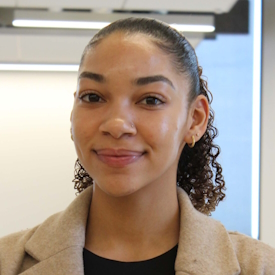
Health Sciences (MHSc) - Community, Public and Population Health
Supervisor
Dr. Caroline Barakat
3MT® PRESENTATION
Enhancing Girls’ Sport Participation through Parental Support: A Mixed-Methods Intervention Study to Develop an Evidence-Based Toolkit
Pre-adolescence is a critical stage when lifelong health habits, like physical activity (PA) and sleep hygiene, begin to form. Organized sports are a key avenue for meeting PA recommendations and provide physical, psychological, and social benefits. However, pre-adolescent girls are less likely than boys to participate in sports, face higher dropout rates, and encounter unique barriers. Parents play a pivotal role in shaping their daughters' sports experiences, yet existing resources often fail to address their specific needs and challenges.
This study explores parental perceptions and decision-making processes regarding girls’ sports participation to bridge this gap. The proposed research has four key objectives: (1) to examine parental perceptions of girls’ sports participation and identify criteria influencing their related decisions; (2) to develop a quantitative tool for assessing factors related to girls’ sports participation; (3) to develop an evidence-informed toolkit to support parental decision-making in relation to girls’ sport participation; and (4) to evaluate the toolkit’s effectiveness in enhancing sports enjoyment and retention across three cohort of girls, those engaged in recreational and competitive sports, as well as those not engaged in any sport programs.
Using a mixed-methods approach, this study combines qualitative insights from interviews with quantitative data, guided by the Model of Parental Involvement in Sports and Newell’s Model of Constraints. By developing and testing a parental toolkit, this research aims to empower parents with practical resources to support sustained sports participation and enjoyment, ultimately promoting lifelong health and well-being for girls.About Jayda
Soccer has been at the core of my life—from Division 1 competition to the professional stage and representing Jamaica internationally. The lessons, opportunities, and growth I’ve gained from sports fuel my passion for research—dedicated to ensuring girls experience the same transformative benefits of sport that shaped my journey.
-
Alicia Kollaard
Program

Health Sciences (MHSc) - Kinesiology
Supervisor
Dr. Shilpa Dogra
3MT® PRESENTATION
Cardiovascular and Immune Responses to Prolonged and Interrupted Sitting
The average Canadian spends about 9.8 hours per day sitting. High amounts of sedentary behaviour like this can increase the risk of several chronic diseases, including cardiovascular disease. Research indicates that men working in sedentary careers are at twice the risk of cardiovascular disease when compared to those working jobs that require physical activity. This increased risk could be explained by inflammation within the blood vessels caused by dysregulation of the inner lining (endothelium). If vascular endothelial cells are disrupted from prolonged sitting, it is thought that vascular growth factor levels would be impacted. My research objective is to examine the response of vascular growth factors (vascular endothelial growth factor, epidermal growth factor, and angiogenesis) to 4-hour bouts of prolonged sitting versus interrupted sitting in young, healthy adults and determine whether these responses differ by sex or fitness level. This work will further our understanding of how prolonged sitting impacts vascular function, and how interrupting sitting can benefit one’s health. It will also provide insights into sex differences in these responses and the protective effects that a higher training status may provide.
About Alicia
I was born in Kendal, right beside Brimacombe ski hill so I grew up skiing and eventually learned to snowboard. I like to bake, go for runs, and am currently learning to play guitar and sew.
-
Alissa Latiff
Program
Health Sciences (MHSc) - Kinesiology
Supervisor
Dr. Meghann Lloyd
3MT® PRESENTATION
Exploring the Lived Experiences of Racialized Parents Who Have Children or Youth with Disabilities: A Descriptive Case Study
In Canada about 6.3 million individuals aged 15 and older have a disability, with that number expected to grow. Disability includes individuals of all races, ethnicities, age, sexual orientations, gender, religions, and socio-economic statuses. A major limitation in understanding the needs of racialized children with disabilities is the lack of data on the intersection between race and ableism. Our research aims to address this gap and examine the intersectionality of race and disability within a pediatric rehabilitation and developmental services context. The primary research question aims to answer the following question: From the perspective of racialized caregivers of children with disabilities, how does race impact the access of services in a community-based pediatric rehabilitation setting? The methodology for this qualitative study consists of a multiple descriptive case study design with three individual, virtual, semi-structured interviews with three different racialized caregivers, for a total of nine interviews. Interviews were approximately 45-60 minutes long and took place about one week apart from each other. To gather comprehensive data, race and disability cannot be examined separately, rather an intersectional approach will be used to examine if being from a doubly marginalized group presents unique challenges or a double burden effect. Interviews were audio recorded with consent, transcribed verbatim, and NVivo 15 was used to code, manage, and analyze data. A community advisory group also helped to inform key decisions made by the research team giving the community the ability to have their voices heard throughout the research process.
About Alissa
I am from the Malvern region in Scarborough, and I like to read and bake in my spare time. I enjoy spending time in nature and learning about different cultures and cuisines. One of my passions is health equity and working towards making communities more inclusive.
-
Maykah Lochan-Aristide
Program

Health Sciences (MHSc) - Kinesiology
Supervisor
Dr. Shilpa Dogra
3MT® PRESENTATION
'We don’t even know they exist’: Why older Black Canadians aren’t engaging in Falls Prevention Exercise Programming?
Research indicates that Black Canadians have the second highest prevalence of falls in Canada and have a higher rate of experiencing the associated risk factors. However, data from current fall-prevention programming shows that only 14% of participants are people of color. As such, the study aims to gain insight into the lived experiences and needs of Black Canadians aged 50 years and older to inform the development of culturally adapted programs.
About Maykah
I was born in Coral Springs, Florida. I lived on the island of Trinidad and Tobago for 4 months. I love to bake and I'm the biggest Tom Brady fan. I've recently become a published author, with papers in, Cities and Health and the Journal of Public Health.
-
Aliyat Olatinwo
Program

Health Sciences (MHSc) - Kinesiology
Supervisor
Dr. Shilpa Dogra
3MT® PRESENTATION
Turning Voices into Choices: Shaping Age-Friendly Programs for Durham
As our population ages, it becomes increasingly important to ensure cities adapt to support older adults. A key goal of such efforts is active aging, emphasizing the engagement of older adults in physical, social, and mental activities that support their overall well-being. However, older adults, particularly from equity-deserving communities, are often excluded from decisions shaping their environments. This study focuses on Durham Region, Ontario, and aims to identify the needs and priorities of diverse older adults related to active aging and age-friendly environments. Using a participatory action research approach, older adults (aged 60 and above) will be active partners in shaping research that reflects their lived experiences and challenges. Guided by the CitieS-Health approach and the World Health Organization’s Age-Friendly framework, the study will involve two phases. First, surveys and workshops with older adults will identify factors influencing active aging and create “fuzzy cognitive maps.” These maps will visually represent the connections between challenges and priorities as identified by participants. In phase two, the findings will be compiled into a report presented at a town hall to policymakers, stakeholders, and municipal leaders. The outcomes will highlight older adults’ priorities, providing practical tools for the Regional Municipality of Durham to improve policies, programming, and infrastructure. By amplifying the voices of older adults, this research will promote health equity and contribute to building inclusive, age friendly cities adaptable to diverse regions. This work offers a scalable model for integrating older adults' perspectives into urban planning and active aging initiatives.
About Aliyat
I'm a first-year Master’s student and I love to crochet in my free time, although, my projects may or may not be multiplying faster than I can finish them! I also enjoy unwinding with a good book, especially adventure novels.
-
Gillian Slade
Program
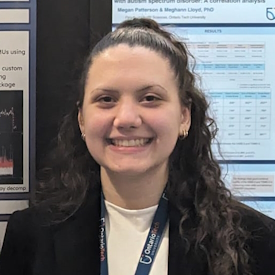
Health Sciences (MHSc) - Kinesiology
Supervisor
Dr. Nicholas La Delfa
3MT® PRESENTATION
The Sweet Spot: Investigating Cycle Time on Shoulder Fatigue During Fixed Overhead Workload
Overhead work is work tasks performed at or above shoulder height. Employees who perform overhead work over an eight-hour workday enhance their risk of developing chronic shoulder pain, and work-related musculoskeletal disorders (WMSDs). These disorders are highly costly for the employee and the employer. Shoulder WMSDs are among the most commonly reported musculoskeletal pains, with many workers experiencing shoulder pain on a monthly basis. Since muscle fatigue and WMSDs are intimately linked, the quantification of muscle fatigue during these tasks can be used to estimate WMSD risk. Under the supervision of Dr. Nick LaDelfa, my research will examine how different overhead cycle times can affect the development of shoulder muscle fatigue, building towards industry guidelines for overhead work. A repeated measures design will be used to assess muscle fatigue during different overhead work cycle times. A total of 20 participants (10M, 10F) aged 18-65 will be recruited using convenience sampling of Ontario Tech University students. Participants will be instrumented with six wireless surface electromyography electrodes to track activity of shoulder in the dominant limb, alongside baseline measurements of maximal strength. In addition, rated perceived exertion and fatigue will be collected using a commonly used ‘Rating of Perceived Exertion’ (RPE) scale and a 10-point visual scale of Ratings of Perceived Fatigue (RPF), respectively. To analyze the practical significance of differences in fatigue development, current ergonomic tools will be used to assess the acceptability of overhead work at various cycle times. Measures of %MVC, RPE, and RPF will be employed.
About Gillian
I am passionate about research in health science. Beyond academia, I enjoy running, strength training, music (I play four instruments) and reading and painting when I'm able to find some free time. I have two cats who keep me company during late night writing sessions.
-
Hamed Tadayyoni
Program

Health Sciences (PhD) – Kinesiology
Supervisor
Dr. Bernadette Murphy and Dr. Alvaro Quevedo
3MT® PRESENTATION
How Virtual Reality Shapes the Way We Learn Movements: Bridging the Gap Between Engineering and Neuroscience
Virtual Reality (VR) is revolutionizing training, rehabilitation, and education, yet we still do not fully understand how it affects one of our most fundamental senses—proprioception, the body's ability to perceive its own position and movement. My research focuses on uncovering neurophysiological biomarkers of proprioception in VR and exploring how different levels of haptic feedback influence motor learning and skill transfer to the real world.
When we interact with the real world, we receive haptic, force, and tactile feedback that helps refine our motor skills. In VR, however, these feedback mechanisms are often altered or missing, which may impact how we learn and retain new skills. My research aims to understand how these differences in sensory feedback affect motor learning and whether the skills acquired in VR translate effectively to real-world tasks. By identifying the underlying neural and behavioral mechanisms, we can determine how VR-based training can be optimized to improve skill acquisition, retention, and real-world applicability.
This research has wide-ranging applications—from designing better VR-based rehabilitation programs for stroke patients to improving virtual training for surgeons and first responders. By identifying biomarkers of proprioception, we can refine VR technologies to make virtual training more immersive, effective, and neurologically aligned with real-world experiences.
Ultimately, my work bridges neuroscience, biomechanics, engineering and human-computer interaction, paving the way for smarter VR systems that enhance learning, rehabilitation, and performance in real-world settings.About Hamed
I’m an engineer-turned-health-sciences researcher, using neuroscience, neurophysiology, math, and programming to study how the brain perceives movement and how VR training differs from reality. Originally from Iran, I’ve studied in three countries—Iran, Turkey, and now Canada—on a journey to bridge tech and health sciences.
Faculty of Science
-
Ainaz Alavi Tabari
Program
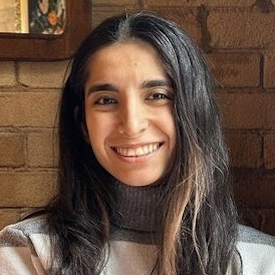
Computer Science (MSc)
Supervisor
Dr. Peter Lewis and Dr. Theresa Stotesbury
3MT® PRESENTATION
Analyzing and Enhancing Robustness and Reliability of Machine Learning Models in Blood Pattern Analysis
In recent years, the use of AI and machine learning has expanded across various applications, including sensitive fields like forensic science. One area where machine learning models are gaining popularity is blood pattern analysis, where they are employed to classify different patterns. However, with the growing reliance on these models, it’s crucial to ensure their robustness and reliability. My thesis focuses on applying machine learning models to classify bloodstain patterns, and using adversarial attacks to test the vulnerability of these models. The goal is to identify potential weaknesses and improve the models to withstand adversarial conditions, ensuring their reliability in forensic investigations.
About Ainaz
I'm a ballet dancer, a drummer, and a computer science student. I love learning and experiencing as much as I can, which is why I enjoy multidisciplinary work that expands my understanding in different fields. Moving from Iran to Canada was one of those exciting experiences.
-
Spencer Hang
Program
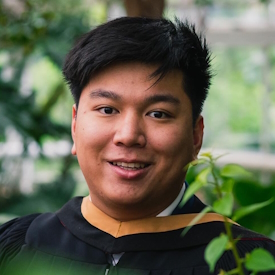
Applied Bioscience (MSc)
Supervisor
Dr. Denina Simmons
3MT® PRESENTATION
How nuclear generators affect the building blocks of life in fish
With the threat of climate change still looming, the Canadian government is investing in cleaner energy sources, with a large emphasis on nuclear energy and the creation of small modular reactors (SMRs).
These house-sized nuclear reactors, estimated to generate $5.4 billion domestically and $150 billion globally by the end of 2040, can replace current fossil fuel methods for power generation and support heavy industries such as mining and oil production. They also have the potential to power small remote communities, giving them access to heat, electricity, and drinking water. While being versatile, SMRs are still in their early stages of development; there is not much known about the effects of the ionizing radiation they produce on the environment around them.
Currently, research on the effects of ionizing radiation on aquatic species has focused on high-exposure, short-term radiation at levels comparable to nuclear disasters such as Fukushima and Chernobyl on early-age fish and invertebrates. These effects show that ionizing radiation causes loss in pigmentation and heart and tail deformities in infant zebrafish and adult shrimp. My research aims to see if low-dose, long-term exposure to radiation affects fish by looking at how it changes the levels of proteins and building blocks found in their blood and body. This information will help make policies surrounding SMRs and potentially measure the amount of radiation emitted from these reactors in their surrounding environment.About Spencer
I'm from Guelph, Ontario, and a big fan of Olivia Rodrigo. My life motto is "When in doubt, pick C." I love science, Magic: The Gathering, karaoke, and cars. A fun fact about me—I still use my childhood stuffed animals to practice presentations!
-
Fanqi Kong
Program

Materials Science (PhD)
Supervisor
Dr. Brad Easton
3MT® PRESENTATION
Next Generation Fuel Cell Catalysts: The Path Towards Sustainable Energy
Fuel cells are a promising alternative to traditional fossil fuels that could provide clean energy for cars, buses, trains and many other applications. In order to make this technology feasible, we need to find better materials to make them cheaper and more durable. One of the most important components of the fuel cell is the catalyst within, which is responsible for driving the necessary chemical reactions for energy production.
A major issue with current catalysts is the usage of precious Platinum metal paired with an unstable carbon support material, resulting in a material with high cost and short lifespan. My research is focused on designing and synthesizing these catalysts from the ground up, aiming to solve these issues by replacing the carbon support with a more stable metal oxide support. This new support also possesses a strong anchoring interaction with the Platinum particles to mitigate detachment mechanisms over time. Overall, this research brings us a step closer to a cleaner and more sustainable future.About Fanqi
I enjoy watching sci-fi movies and TV shows. Also, I like to tinker with electronics, such as building PCs or troubleshooting various software.
Faculty of Social Science and Humanities
-
Jessica Biasin
Program

Forensic Psychology (MSc)
Supervisor
Dr. Taylor Heffer
3MT® PRESENTATION
Mapping Non-Linear Trajectories of Honesty-Humility and Sensitivity to Punishment from Childhood to Adolescence
Adolescence, a transitional stage of human development spanning from age 10 to 19, is marked by significant biological, social, and psychological changes contributing to an increased susceptibility to various psychological challenges (Costello et al., 2011). My research focuses on the non-linear development of Honesty-Humility (HH), which encompasses traits such as fairness, and integrity, and Sensitivity to Punishment (SP), an individuals’ sensitivity to aversive stimuli. While prior studies have relied on linear and categorical models to suggest a ‘peak’ in adolescent dishonesty (Dykstra et al., 2020a, 2020b; Debey et al., 2015; Levine et al., 2013), the non-linear development of HH and the role of SP in age-related differences remain underexplored.
Using longitudinal data from over 1,200 participants aged 7 to 14 at baseline and spanning seven years, this study employs advanced statistical models, namely Generalized Additive Models (GAMs) to track how these traits evolve. This approach will allow us to capture the complexities of personality change and provide a more nuanced understanding of how HH develops within this critical period of the human lifespan (Sullivan et al., 2015).
By understanding these developmental trajectories, my research seeks to identify periods of growth and stability, offering insights into the interaction between personality traits and threat responses. These findings will inform strategies for supporting youth during this transformative stage of life, paving the way for adolescent well-being. Ultimately, this work contributes to the broader understanding of personality development, emphasizing the importance of fostering honesty during adolescence.About Jessica
I’m a graduate student at Ontario Tech University with a passion for forensic psychology and youth mental health. Outside of research, I find great rewards from volunteering at various institutions including Ontario Shores Centre for Mental Health Sciences, Durham Region Victim Services, Canadian Psychological Association, and more.
-
Melissa Handford
Program

Forensic Psychology (MSc)
Supervisor
Dr. Leigh Harkins
3MT® PRESENTATION
Understanding Victim Decisions to Report Non-Consensual Intimate Image Distribution
Non-consensual intimate image distribution (NCIID) involves the creation, distribution, and threatening of distribution of intimate images, without the consent of those in the image. These images can be spread through social circles, posted online, used as blackmail, and more. These images are often impossible to remove from the Internet, and victims often face ridicule, blame, and loss of educational and employment opportunities as a result. Despite its growing frequency, NCIID is not often reported to police, prosecuted, or convicted. To date, no studies have used an experimental design to investigate victim perceptions and behaviours regarding NCIID laws and legal practices. This research will examine factors associated with NCIID, including what influences a person to report NCIID and the characteristics of NCIID cases that are reported to law enforcement. It will seek to determine how image attainment, distribution method, victim gender and relation, and cognitive factors such as confidence in the justice system and rape myth acceptance, factor into a victim’s decision to report the incident to law enforcement. These results will be compared to Canadian legal cases involving NCIID, to assess a possible correlation between the factors that contribute to a participant or a real-world victim deciding to report an incident. Understanding participant decisions regarding contacting police will gain insight into the perceived effectiveness of NCIID laws, resulting in better legal options for victims. The results of the proposed research have the potential to strengthen legal practices, victim support services, and laws to be more effective deterrents and prosecutors.
About Melissa
I am a first-year MSc student in Forensic Psychology under the supervision of Dr. Leigh Harkins. In my free time, I like to watch movies, cook pasta, and plan where I want to travel to next!
-
Varvara Ninowksy
Program

Forensic Psychology (MSc)
Supervisor
Dr. Matthew Shane
3MT® PRESENTATION
Ties That Bind: Social Closeness and Empathy in Individuals with Psychopathic Traits
It is generally believed that individuals with high psychopathic traits are incapable of experiencing empathy, but emerging research says otherwise, stating that these individuals can express empathy when explicitly asked to do so.
This research will investigate the role of social closeness in motivating individuals to empathize with others, for both virtuous (other person’s benefit) and nonvirtuous (your own benefit) purposes. The main hypothesis is that social closeness will increase the likelihood of virtuous empathy in this population, as they are motivated to empathize with those they perceive as close (e.g., family or friends) due to familiarity and potential instrumental benefits, such as maintaining useful relationships. Conversely, these individuals are expected to display nonvirtuous empathy, such as manipulation, in interactions with socially distant individuals or outgroup members.
The study would involve 200~ participants recruited from a research pool, assessing psychopathic traits through the PPI-R-40 scale and empathy motivations using a Motivation to Empathize Scale. Additionally, they will complete a categorization task to assign various individuals into ingroup, outgroup, or indifferent categories, providing insight into the interplay between psychopathy, social closeness, and empathy. Exploratory questions will help understand the nature behind one’s decision to empathize/not to empathize in specific scenarios.
No prior research has comprehensively examined all three aspects together (psychopathy, social closeness, and motivation to empathize), which this study aims to address. The findings will contribute to understanding empathy’s role in social and prosocial behavior within psychopathy, with implications for therapeutic interventions and social relationship frameworks.
About Varvara
Although I've had a Canadian passport my entire life, this is only my third year living here.